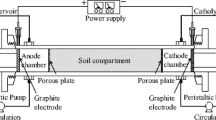Abstract
A combined process comprised of electro-Fenton and bioslurry (EF–bioslurry) was developed at lab scale for remediating a real coking plant soil with an initial polycyclic aromatic hydrocarbons (PAHs) content of 3605 mg/kg. Sodium citrate was used as a complexant to keep the iron in solution at near-neutral pH conditions for increasing the reaction rate. The appropriate order of application was to perform EF process followed by bioslurry, which was evaluated through analysis of degradation characteristics of individual processes. The optimum EF duration was assessed through an analysis of the induced changes in PAHs degradation and bacterial counts. The optimum application time of EF process was determined to be 24 h. The removal of PAHs was 95.2% for EF–bioslurry after 40 days, and the efficiency was increased by almost 150%, compared with the individual bioslurry treatment. The EF reaction caused significant cell death and high inhibition to polyphenol oxidase (PPO) activity of soil. The bacterial activity and counts in the slurry recovered rapidly after EF oxidation through the addition of raw soil (2%, w/w). Therefore, the combined process of EF–bioslurry process may be an efficient and promising approach for the remediation of highly organic-contaminated soil.







Similar content being viewed by others
References
Chen, F., Tan, M., Ma, J., Li, G., & Qu, J. (2016a). Restoration of manufactured gas plant site soil through combined ultrasound-assisted soil washing and bioaugmentation. Chemosphere, 146, 289–299.
Chen, F., Tan, M., Ma, J., Zhang, S., Li, G., & Qu, J. (2016b). Efficient remediation of PAH-metal co-contaminated soil using microbial-plant combination: A greenhouse study. Journal of Hazardous Materials, 302, 250–261.
Cheng, M., Zeng, G., Huang, D., Lai, C., Xu, P., Zhang, C., & Liu, Y. (2016). Hydroxyl radicals based advanced oxidation processes (AOPs) for remediation of soils contaminated with organic compounds: A review. Chemical Engineering Journal, 284, 582–598.
de Luna, M. D., Veciana, M. L., Su, C. C., & Lu, M. C. (2012). Acetaminophen degradation by electro-Fenton and photoelectro-Fenton using a double cathode electrochemical cell. Journal of Hazardous Materials, 217–218, 200–207.
Han, W., Luo, L., & Zhang, S. (2013). Adsorption of tetrabromobisphenol a on soils: Contribution of soil components and influence of soil properties. Colloids and Surfaces A, 428, 60–64.
Jen, J. F., Leu, M. F., & Yang, T. C. (1998). Determination of hydroxyl radicals in an advanced oxidation process with salicylic acid trap** and liquid chromatography. Journal of Chromatography. A, 796, 283–288.
Li, X., Li, J., Sui, H., He, L., Cao, X., & Li, Y. (2018). Evaluation and determination of soil remediation schemes using a modified AHP model and its application in a contaminated coking plant. Journal of Hazardous Materials, 353, 300–311.
Lu, M., & Zhang, Z. Z. (2014). Phytoremediation of soil co-contaminated with heavy metals and deca-BDE by co-planting of Sedum alfredii with tall fescue associated with Bacillus cereus JP12. Plant and Soil, 382, 89–102.
Lu, M., Zhang, Z., Qiao, W., Wei, X., Guan, Y., Ma, Q., & Guan, Y. (2010). Remediation of petroleum-contaminated soil after composting by sequential treatment with Fenton-like oxidation and biodegradation. Bioresource Technology, 101, 2106–2113.
Lu, Y. F., & Lu, M. (2014). Remediation of pah-contaminated soil by the combination of tall fescue, arbuscular mycorrhizal fungus and epigeic earthworms. Journal of Hazardous Materials, 285, 535–541.
Mousset, E., Trellu, C., Oturan, N., Rodrigo, M. A., & Oturan, M. A. (2017). Soil remediation by electro-Fenton process, In electro-Fenton process (pp. 399–423). Singapore: Springer.
Ghosal, D., Ghosh, S., Dutta, T. K., & Ahn, Y. (2016). Current state of knowledge in microbial degradation of polycyclic aromatic hydrocarbons (PAHs): A review. Frontiers in Microbiology, 7, 1369.
Gong, X. B. (2012). Remediation of weathered petroleum oil-contaminated soil using a combination of biostimulation and modified Fenton oxidation. International Biodeterioration & Biodegradation, 70, 89–95.
Pant, A., & Rai, J. P. N. (2018). Bioremediation of chlorpyrifos contaminated soil by two phase bioslurry reactor: Processes evaluation and optimization by Taguchi's design of experimental (DOE) methodology. Ecotoxicology and Environmental Safety, 150, 305–311.
Smith, E., Thavamani, P., Ramadass, K., Naidu, R., Srivastava, P., & Megharaj, M. (2015). Remediation trials for hydrocarbon-contaminated soils in arid environments: Evaluation of bioslurry and biopiling techniques. International Biodeterioration & Biodegradation, 101, 56–65.
Yap, C. L., Gan, S., & Ng, H. K. (2011). Fenton based remediation of polycyclic aromatic hydrocarbons-contaminated soils. Chemosphere, 83, 1414–1430.
Yu, X. Z., Wu, S. C., Wu, F. Y., & Wong, M. H. (2011). Enhanced dissipation of PAHs from soil using mycorrhizal ryegrass and PAH-degrading bacteria. Journal of Hazardous Materials, 186, 1206–1217.
Acknowledgements
The authors wish to thank the National Natural Science Foundation of China (no. 51768018) for their support.
Author information
Authors and Affiliations
Corresponding author
Additional information
Publisher’s Note
Springer Nature remains neutral with regard to jurisdictional claims in published maps and institutional affiliations.
Rights and permissions
About this article
Cite this article
Liu, Z., Gao, Z. & Lu, X. An Integrated Approach to Remove PAHs from Highly Contaminated Soil: Electro-Fenton Process and Bioslurry Treatment. Water Air Soil Pollut 231, 314 (2020). https://doi.org/10.1007/s11270-020-04696-7
Received:
Accepted:
Published:
DOI: https://doi.org/10.1007/s11270-020-04696-7




